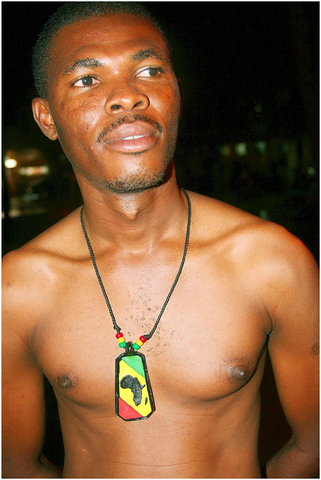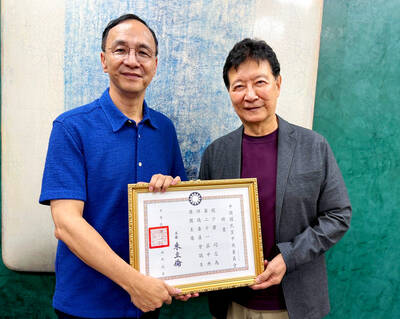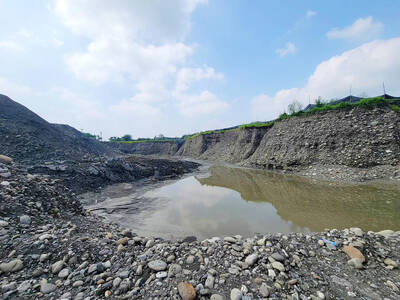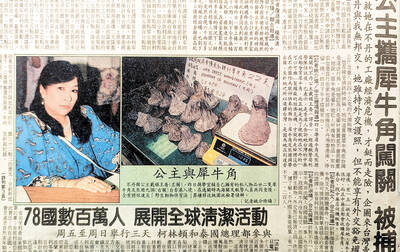Your favorite group of African musicians not only has a new sound but is branching out into fashion this week.
The Pan Africana Cultural Troupe has been performing in Taiwan for the past four years and has built up a steady following with its frequent gigs and occasional TV appearances.
Led by the enterprising Ben Stobite Sampson and the musically challenging Rankin' Kim Douglas the ever-evolving group has a more Caribbean lilt these days.

PHOTO: JULES QUARTLY, TAIPEI TIMES
A steel drum, xylophone and trumpet have been added to the base sound of African drums and the result is a tighter and more melodic sound that will attract new fans.
Outside the band's studio in Shida, Taipei, Sampson reaches into his suitcase and pulls out some men's shirts and women's dresses, all in brilliant colors and patterned with animal prints.
A leather bag made of bush goat is deep brown and has white leather stitching and innovative tooling. Sandal uppers are fashioned from goat hide and the soles are made from car tires.
There are also dried-wood African pendants, bracelets constructed out of colored electrical wire and big round nteh seeds formed into necklaces.
Sampson has just started importing textiles and jewelry from Takoradi in his native Ghana and plans to expand his business to China and other Asian nations.
“I want to open up the market to African goods,” Sampson said.
“Europeans and Americans know about these things but here people are still learning.”
Pan Africana will be showcasing its new sound and putting on a fashion show this tomorrow, at Sappho, starting at 10pm. The lounge bar is located at B1, 1, Ln 102, Anhe Rd, Sec 1, Taipei (台北市安和路1巷1號B1). Entrance is NT$200.
For more information visit www.panafricana.blogspot.com.

Next week, candidates will officially register to run for chair of the Chinese Nationalist Party (KMT). By the end of Friday, we will know who has registered for the Oct. 18 election. The number of declared candidates has been fluctuating daily. Some candidates registering may be disqualified, so the final list may be in flux for weeks. The list of likely candidates ranges from deep blue to deeper blue to deepest blue, bordering on red (pro-Chinese Communist Party, CCP). Unless current Chairman Eric Chu (朱立倫) can be convinced to run for re-election, the party looks likely to shift towards more hardline

Last week the story of the giant illegal crater dug in Kaohsiung’s Meinong District (美濃) emerged into the public consciousness. The site was used for sand and gravel extraction, and then filled with construction waste. Locals referred to it sardonically as the “Meinong Grand Canyon,” according to media reports, because it was 2 hectares in length and 10 meters deep. The land involved included both state-owned and local farm land. Local media said that the site had generated NT$300 million in profits, against fines of a few million and the loss of some excavators. OFFICIAL CORRUPTION? The site had been seized

Sept. 15 to Sept. 21 A Bhutanese princess caught at Taoyuan Airport with 22 rhino horns — worth about NT$31 million today — might have been just another curious front-page story. But the Sept. 17, 1993 incident came at a sensitive moment. Taiwan, dubbed “Die-wan” by the British conservationist group Environmental Investigation Agency (EIA), was under international fire for being a major hub for rhino horn. Just 10 days earlier, US secretary of the interior Bruce Babbitt had recommended sanctions against Taiwan for its “failure to end its participation in rhinoceros horn trade.” Even though Taiwan had restricted imports since 1985 and enacted

Enter the Dragon 13 will bring Taiwan’s first taste of Dirty Boxing Sunday at Taipei Gymnasium, one highlight of a mixed-rules card blending new formats with traditional MMA. The undercard starts at 10:30am, with the main card beginning at 4pm. Tickets are NT$1,200. Dirty Boxing is a US-born ruleset popularized by fighters Mike Perry and Jon Jones as an alternative to boxing. The format has gained traction overseas, with its inaugural championship streamed free to millions on YouTube, Facebook and Instagram. Taiwan’s version allows punches and elbows with clinch striking, but bans kicks, knees and takedowns. The rules are stricter than the